‘Automation’ is Key in Accelerating Business Velocity through Digital Transformation: Arunava Paul [Testμ 2022]
LambdaTest
Posted On: September 2, 2022
![]() 17367 Views
17367 Views
![]() 11 Min Read
11 Min Read
You’ve probably seen and heard people gushing about the digital transition by this point. It is the most popular buzzword that ranks within the top ten. Another competitor for first place is automation. But why is there a difference if both focus on increasing business operations’ efficiency?
In this session of the Testμ Conference, Arunava Paul, Head of Innovation and COE, Qualizeal, teamed up with Somesh Ojha, Director of Sales, LambdaTest, to emphasize the role of automation in helping fast-paced businesses achieve digital transformation.

In the field of Software Quality Engineering and Assurance, Arunava has 18 years of experience. He has a wealth of expertise managing test automation portfolios for major banks, working on prestigious BFS engagements across international borders, and managing Testing Services and Automation Centers of Excellence.
His experience with automation spans many areas, including service virtualization, testing Microservices APIs, classic GUI automation, and mobile test automation. Additionally, he assists with consultation, gap analyses, due diligence, framework implementation, proposal presentations, automation evaluations, and transformation projects.
He started the talk by highlighting the agenda of the meeting:
Agenda:
- Abstract.
- What is digital transformation?
- Automation is key in the world of digital transformation.
- Various automation in details
- Cost of Quality
“Quality is everyone’s responsibility” – William Edwards Deming.
Accelerating business velocity has become the new theme in the world of digital transformation and has resulted in a higher degree of automation awareness across the IT life cycle. The industry is striving toward accelerating the release life cycle through various automation initiatives and workforce transformation. The research says enterprises want to achieve 60 percent automation to address consumer needs. In this session, Arunava Paul discussed how we look into the new-age automation, tools, and key best practices.
Digital transformation
Digital transformation is a technology-driven process of radically changing a business to bring value to its customers and pave its way toward growth.
Digital transformation is different for every organization, and it can be hard to pinpoint a definition that applies to all. In general, digital technology integration into all areas of business results in fundamental changes to how businesses operate and deliver value to customers. It also needs a culture change that requires the organization to understand and adopt a path of challenging the status quo, innovate more, and get faster feedback for better improvement.
Arunava dives in further and explains the elements. Although Digital Transformation is different for every organization – Common Elements of Digital Transformation are:
- Customer Experience – Bringing value to customers, understanding customer needs, and using AI to serve customers better.
- Operating Agility – Increasing Operational agility and reducing operations costs through process automation.
- Culture and Leadership – Creating a culture and environment that embraces the new digital changes.
- Workforce Enablement – Training the workforce to prepare for transformation and empower them with tools and knowledge.
Real-World Examples of Digital Transformation
Banking Sector:
The banking sector is the rising demand for Artificial Intelligence (AI), Blockchain, and the Internet of Things (IoT), modernizing the banking industry.
- Omni channel banking.
- Analytics-Driven Marketing.
- Customer Service.
- Credit decisioning.
- Regulatory Compliance.
Insurance Sector:
- Claims Processing.
- Claims fraud detection.
- Analytics-Driven underwriting/Risk Scoring.
- Reports Automation.
Telecom Sector:
- SC Network – The Network of Today and Tomorrow
- Internet of Things and Telemetrics – enable better communication between people and devices
Healthcare Sector:
- Virtual Visits of telemedicine.
- Omnichannel Patient Portals.
- Blockchain and Medical records.
- Voice systems and chatbots to screen patients and reduce the load for patient support staff.
Automotive Sector:
- Predictive maintenance using IoT.
- Virtual showrooms and Video Screens for purchasing vehicles.
- Autonomous driving / self-driving.
- Alternative rules for environment and cost.
Automation is key in the world of digital transformation
He claims, “Automation is a key to accelerate business velocity and to make Digital Transformation successful.” He says the snapshot below is the complete view of today’s talk.
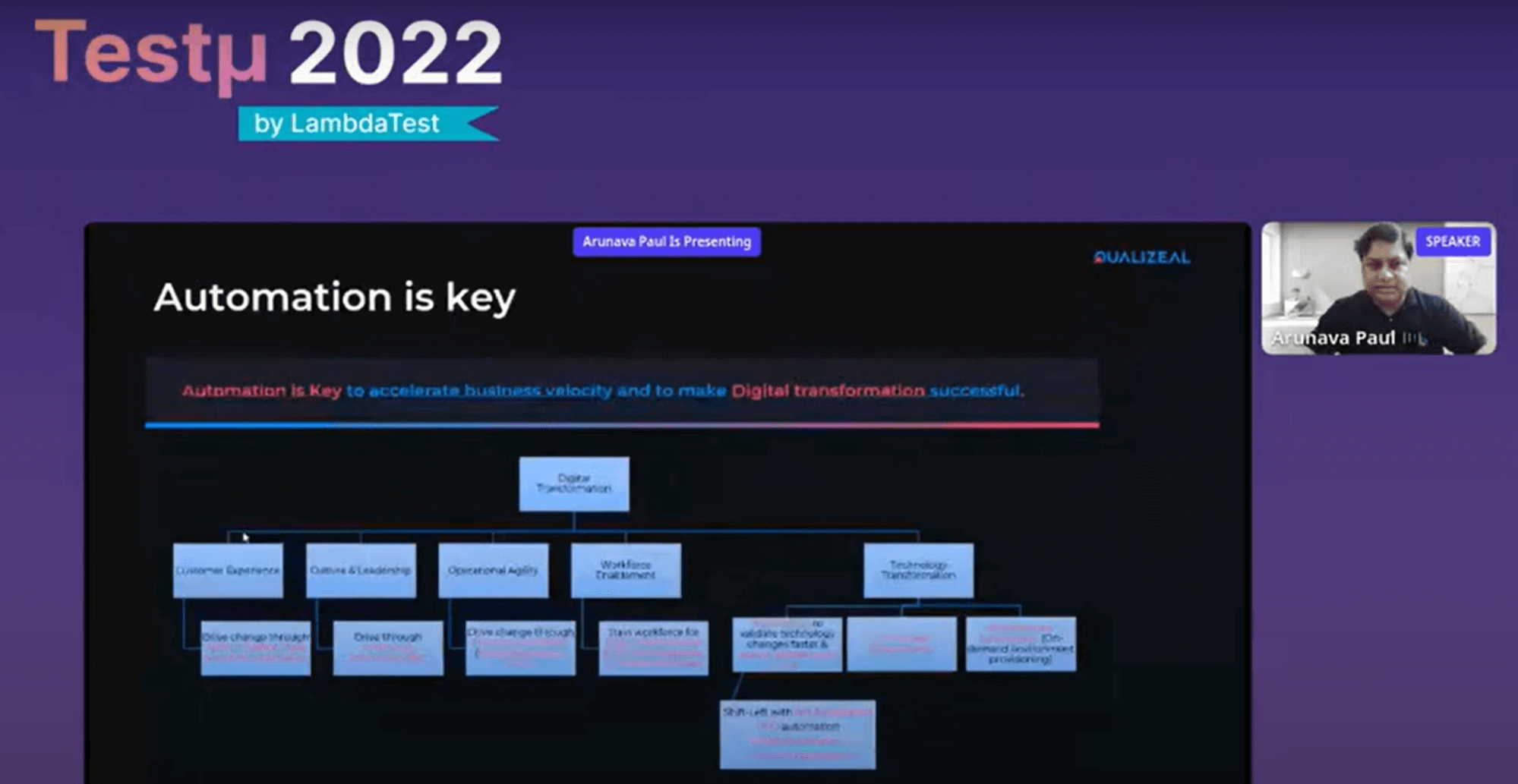
Customer Experience – Automation Areas
52% of all Internet traffic now comes from mobile, with desktop usage steadily declining. It’s projected that by 2025. 92% of internet use will be mobile-based. Mobile apps are no longer the answer. 61% of consumers will not download an app to communicate with a business. Responsive websites powered with AI, Data analytics, and chatbots are gaining pace.
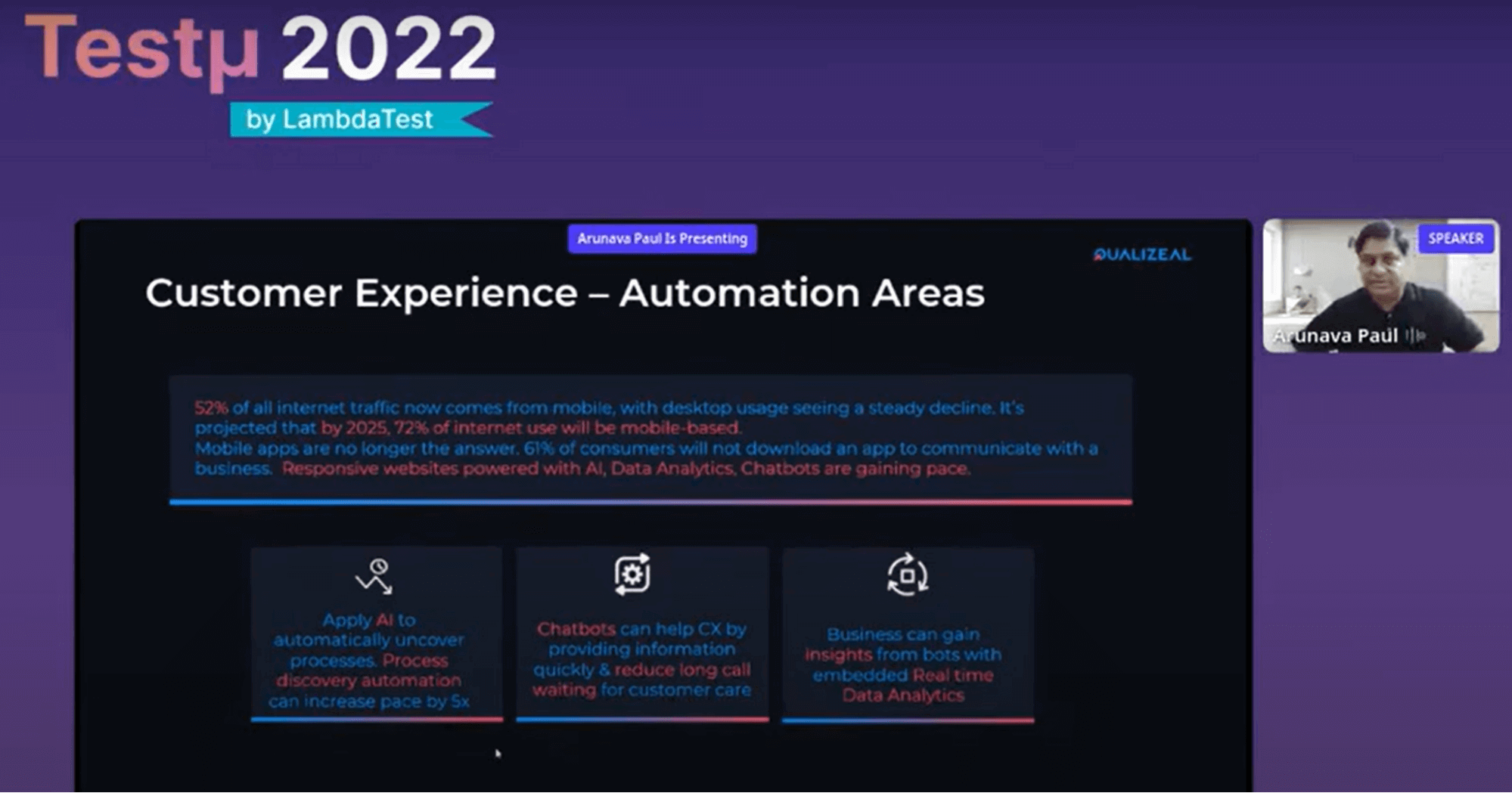
- Apply AI to uncover processes automatically. Process discovery automation can increase the pace by 5x.
- Chatbots can help CX by providing information quickly and reducing long calls waiting for customer care.
- Businesses can gain insights with embedded real-time data analytics.
Culture and Leadership – Automation Areas
What role does culture play in digital transformation? Organizations need to follow a mindset transformation and support continuous innovation and R&D. Embracing this shift requires everyone in the company to rethink and adopt a culture of “Let’s build and create new capabilities that didn’t exist before.”
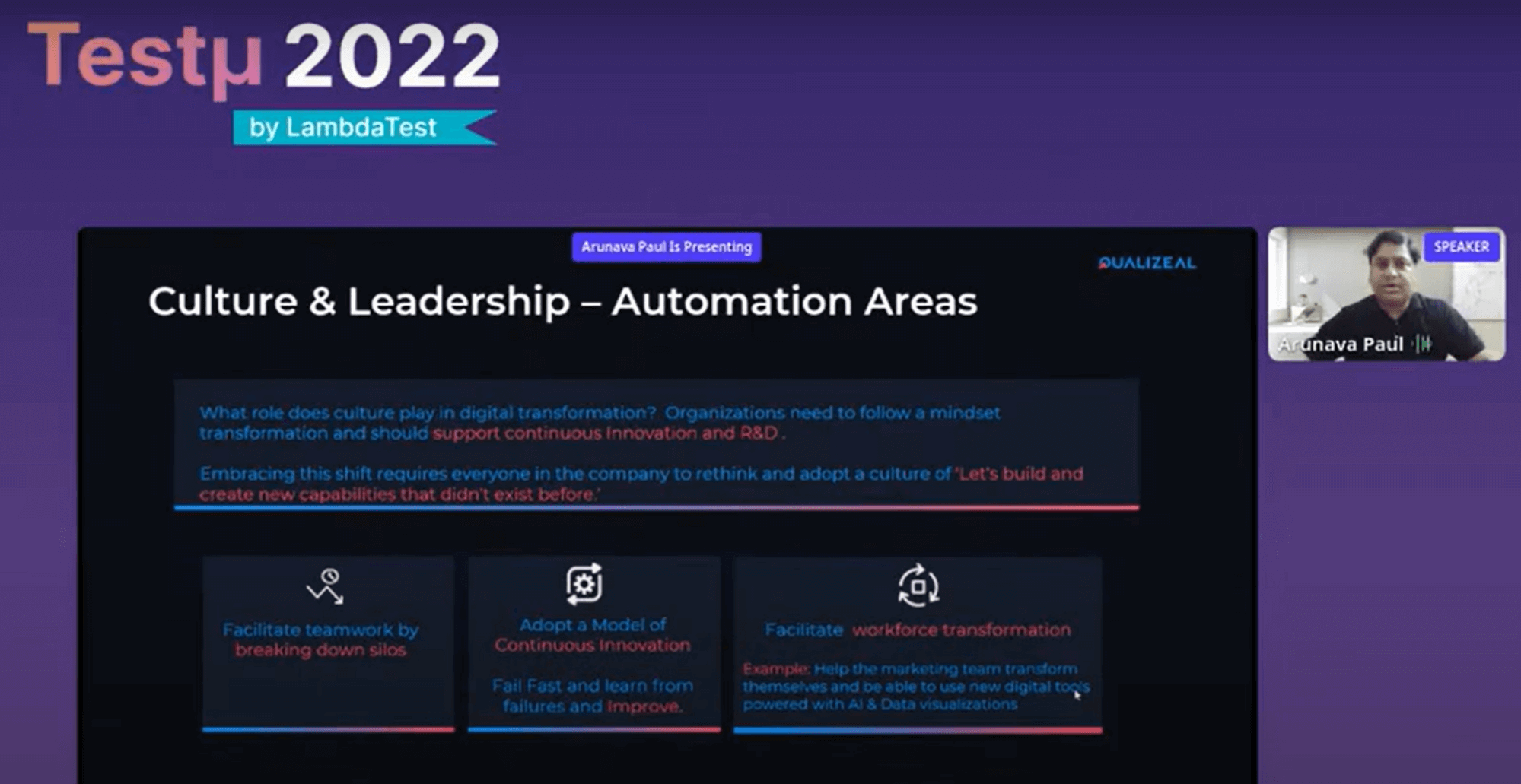
- Facilitate teamwork by breaking down silos.
- Adopt a model of Continuous Innovation.
- Fail fast and learn from failures and improve.
- Facilitate workforce transformation.
- Help the marketing team transform themselves and be able to use new digital tools powered with AI & Data visualizations.
Operational Agility – Automation Areas
To bring Operation agility, process automation is the key to Digital Transformation. Automating day-to-day workflows lies at the heart of successful digital transformation. Without workflow automation, organizations are still dealing with manual processes, in case the threat of being disrupted and becoming irrelevant is real.
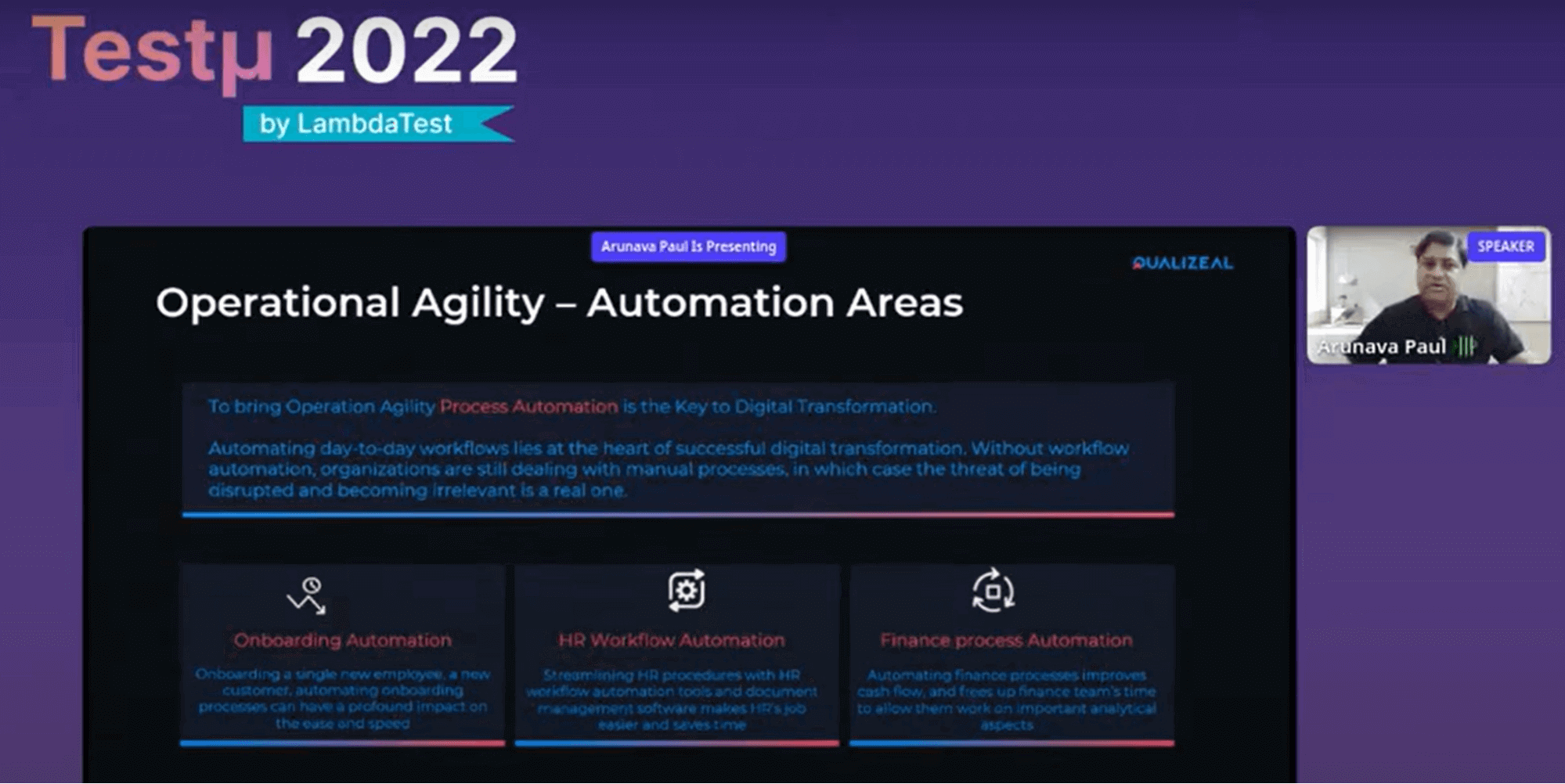
- Onboarding Automation: Onboarding a single employee or a new customer and automating the onboarding process can profoundly impact ease and speed.
- HR Workflow Automation: Streamlining HR procedures with workflow automation tools and document management software makes HR’s job easier and saves time.
- Finance Process Automation: Automating finance processes improves cash flow and frees up the finance team’s time to allow them to work on critical analytical aspects.
Workforce Transformation
Workforce transformation is an important aspect of Digital Transformation and can help organizations accelerate transformation with rightly skilled teams. Workforce transformation refers to realigning a company’s employee base to ensure that its skills match its strategic needs.
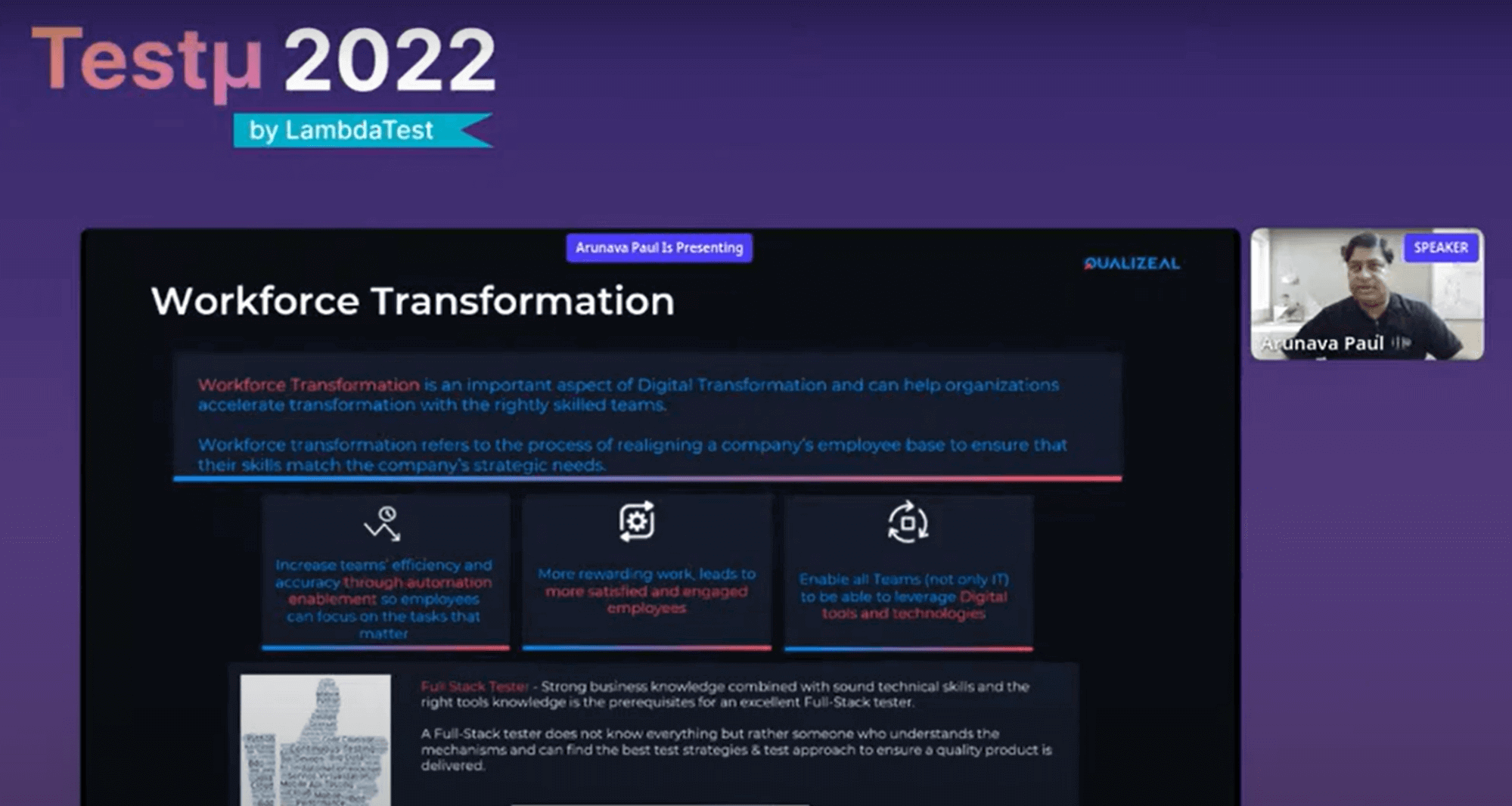
- Increase team efficiency and accuracy through automation enablement so employees can focus on the tasks that matter.
- More rewarding work leads to more satisfied and engaged employees.
- Enable all teams to be able to leverage Digital tools and technologies.
- Full Stack tester: Strong business knowledge, sound technical skills, and the right tool knowledge are prerequisites for an excellent full-stack tester.
- A full stack tester does not know everything but someone who understands the mechanisms and can find the best test strategies and test approach to ensure quality is delivered.
Technology Transformation – New age automation
He further explains the New age of automation. You can have automation without digital transformation, but not the other way around. A principal cloud evangelist, Leon Godwin, says, “Digital transformation improves processes, while automation adds speed and reduces costs.” Ultimately digital transformation delivers more business value when combined with process efficiency, enabled by automation.
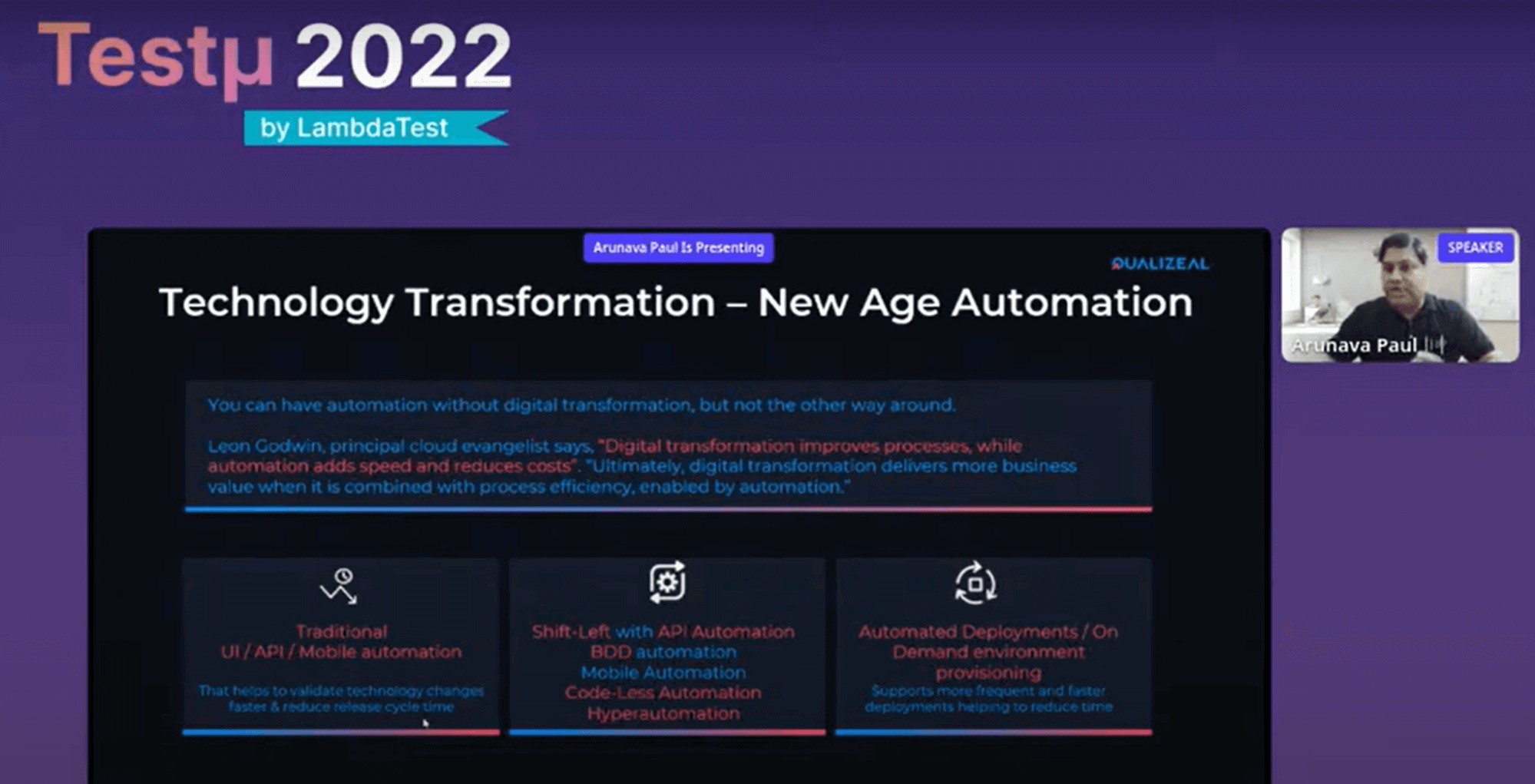
- Traditional UI/API/Mobile automation – That helps to validate technology changes faster and reduce release cycle time. Cloud-based platforms like LambdaTest play a vital role in this space by enabling cross-browser and cross-device testing at scale.
It is an AI-native text orchestration and execution platform that lets you perform manual and automated tests at scale across 5000+ real devices, browsers and OS combinations.
This platform offers features like parallel execution, real-time debugging, and CI/CD integrations; LambdaTest accelerates automation efforts while ensuring quality across environments.
- Shift left with API automation, BDD automation, mobile automation, code-less automation, and hyper automate.
- Automated deployment/On-demand environment provisioning – Supports more frequent and faster deployments helping to reduce time.
Cost of Quality
Cost of Quality is a method for calculating the costs companies incur, ensuring that products meet quality standards and the cost of producing goods that fail to meet quality standards.
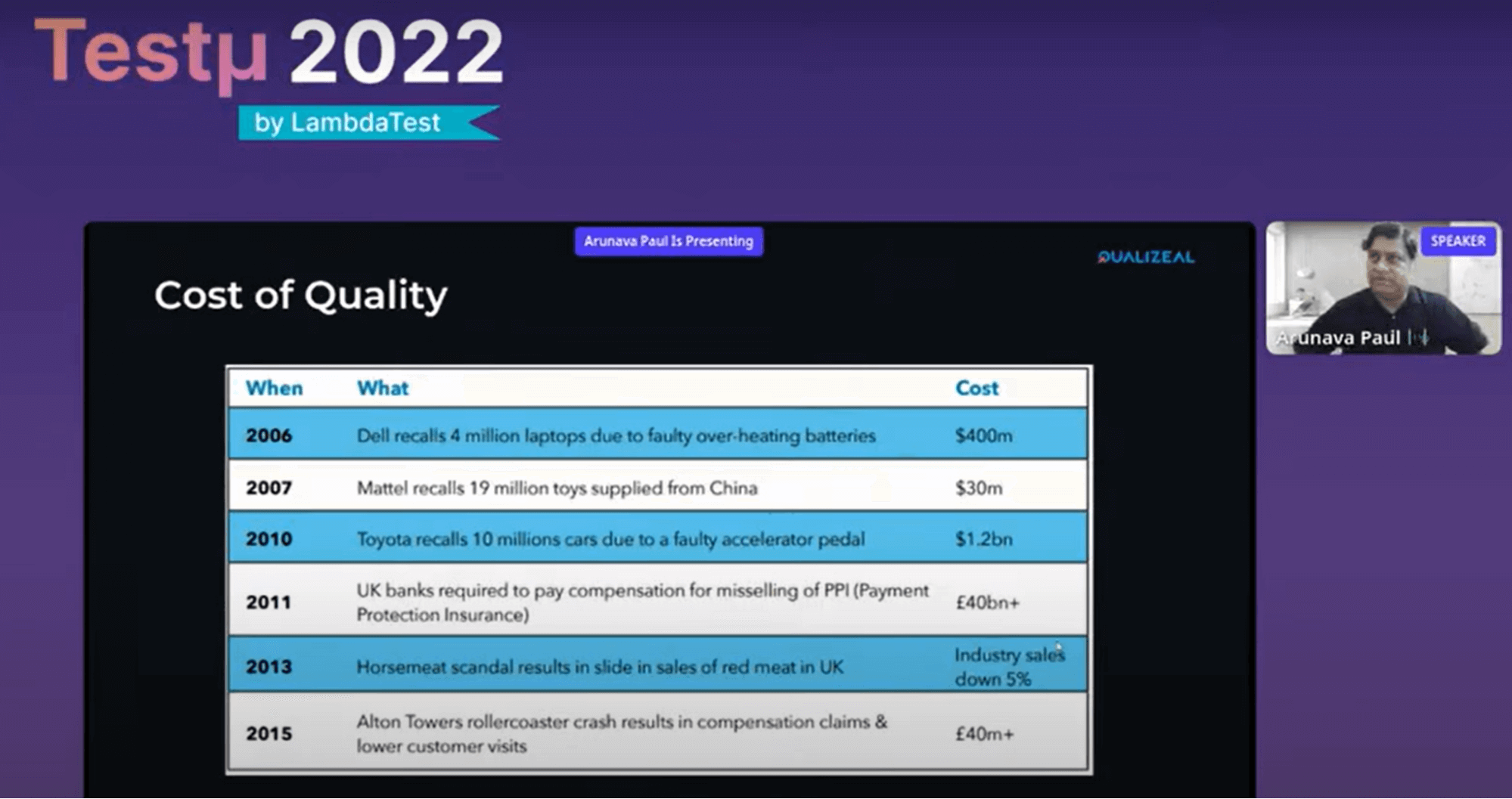
Cost of Quality = Prevention cost + Appraisal cost + Internal failure + External Failure costs
- Testing Early and continuously testing can help us reduce the Cost of Quality.
- Shift-Left with API automation helps teams to start automating early and getting early feedback reducing the Cost of Quality.
- Testing should be everyone’s responsibility.
- BDD methodology suggests scenarios should be created following the Three Amigos process involving Business Analyst, Developer, & QA.
- The impact of the defects can measure the cost of defects and when we find them. Earlier, the defects’ cost was found to be lesser.
For example, if a defect or issue is found in the requirement specifications during the requirements gathering and analysis phase, it is cheaper to fix it than if found in the later stages of SDLC.
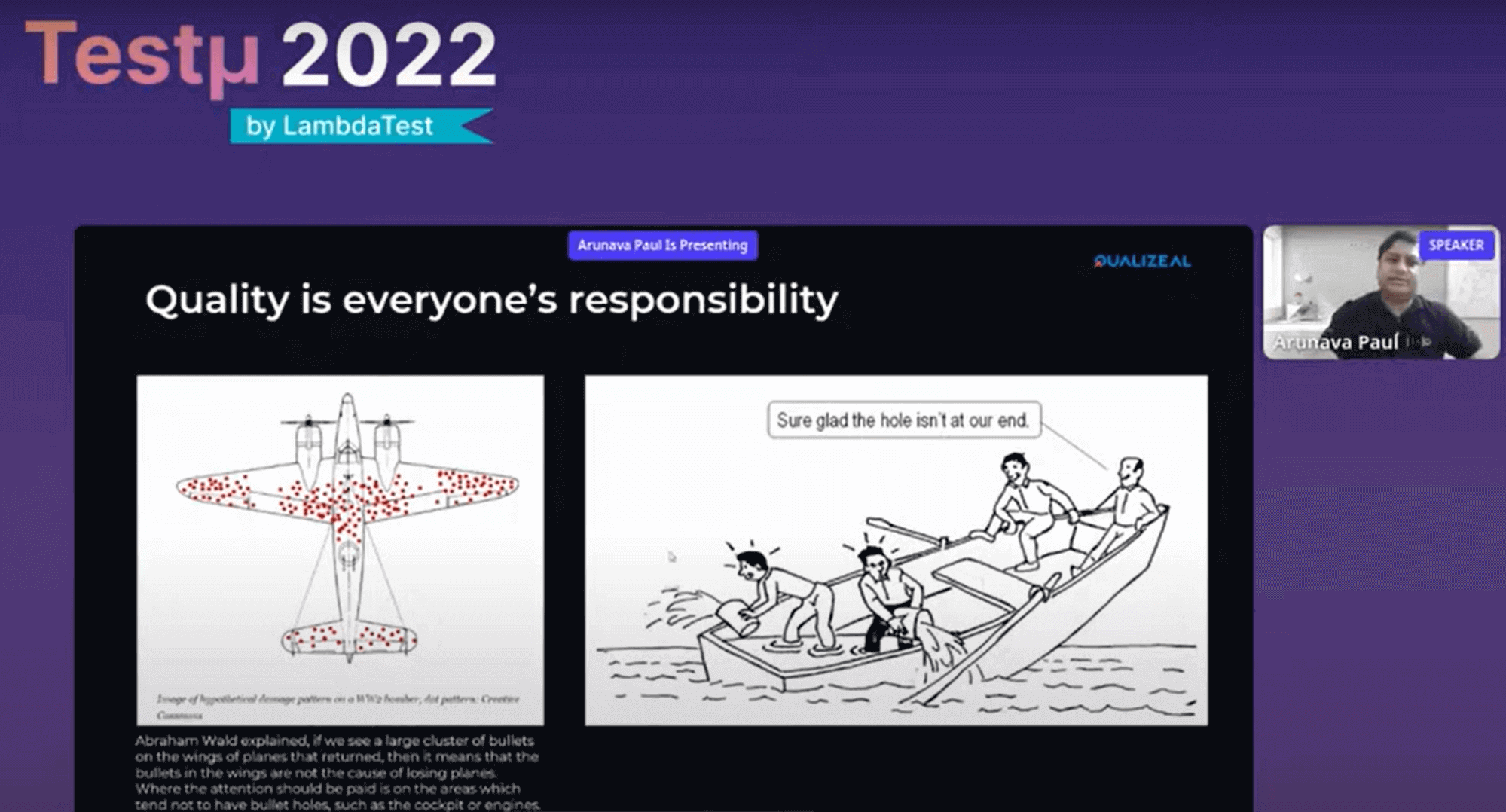
Statistics
Where can digital transformation make an impact? He explains the statistics below:
- Market Growth Rate
- Digital Tx Initiatives
- Emerging Technologies
Direct digital transformation investment is expected to grow at a compound annual CADRE OF 18% from 2000 to 2003. By 2021, it is expected to approach $7 billion as companies build on existing strategies and investments, becoming digital-at-scale future enterprises (IDC).
40% of all technology spending will go toward digital transformation, with enterprises spending more than $2 trillion in 2019 (IDG). Digital Tx is expected to add $100 trillion to the world economy by 2025 (World Economic Forum).
At least 90% of a few enterprise apps will insert Al technology into their processes and products by 2025 (IDC). Intelligent systems will drive 70% of your customer engagements by 2025 (Gartner).
Digital Transformation Benefits
- Executives say the top benefits of digital transformation are improved operational efficiency (406), faster time to market (36%), and the ability to meet customer expectations (35%) (PTC).
- 56% of CEOs say digital improvements have led to increased revenue. (Gartner)
- Digitally mature companies are 23% more profitable than their less mature peers. (MIT).
- High-tech B2B companies have reported a 10% to 20% cost reduction and revenue growth of 10% to 15% from transforming their customer experience process.
- 74% of business buyers say they will pay more for better Digital Transformations.
Best Practices to meet Digital Transformation
What is the best way to scope, scale, and lead the digital transformation that can deliver financial results?
Below is the Gartner IT Roadmap for Digital Transformation – based on unbiased research and interactions with thousands of organizations that have successfully implemented digital business transformation initiatives.
- Ambition
- Design
- Delivery
- Scale
- Refine
It was indeed an insightful session with Arunava. The session ended with a few questions asked by the attendees to Arunava. Here is the Q&A:
- How will HyperAutomation affect the people who are more dependent on Manual workings?
- Currently, codeless test automation is also rising. Is it reliable to use? What’s your opinion on it?
- How much has automation helped small businesses? Can you cite some examples?
Arunava: Automation is key. I explained my point of view that we could not support digital transformation without automation. We are doing digital transformation to fast-track the business to go to the market flawlessly and fast. We don’t want to slow down. So people who are more into the manual, need to support the organization’s view for digital transformation. To go to the market faster, we need to bring the keyway at the same level of speed.
Arunava: Codeless test automation is rising, and tools support codeless automation very efficiently. But some other tools are still in a very initial stage and will probably gain market share in the future. In some projects, we do not have enough skilled resources who can drive the automation right.
So there, we can think about codeless test automation, that can be plugged in to get a quick answer or a quick check about the application. Highly skilled automation engineers are probably the codeless automation engineers that can help in the future. Definitely, codeless automation will gain space, and it will be more beneficial to everyone.
Arunava: Instead of manually reviewing applications, we can use automation if a product needs to reach the market more quickly. Despite the fact that it is a tiny business, automation allows us to observe what is not operating as intended and what is not working at all. We must fail quickly. We cannot wait till something is broken for us to realise it. In order to help the company get into production more quickly, we must fail quickly and gather knowledge.
After the successful Testμ Conference 2022, where thousands of testers, QA professionals, and developers worldwide joined together to discuss on future of testing.
Join the testing revolution at LambdaTest Testμ Conference 2023. Register now!” – The testing revolution is happening, and you don’t want to be left behind. Join us at LambdaTest Testμ Conference 2023 and learn how to stay ahead of the curve. Register now and be a part of the revolution.
Got Questions? Drop them on LambdaTest Community. Visit now














